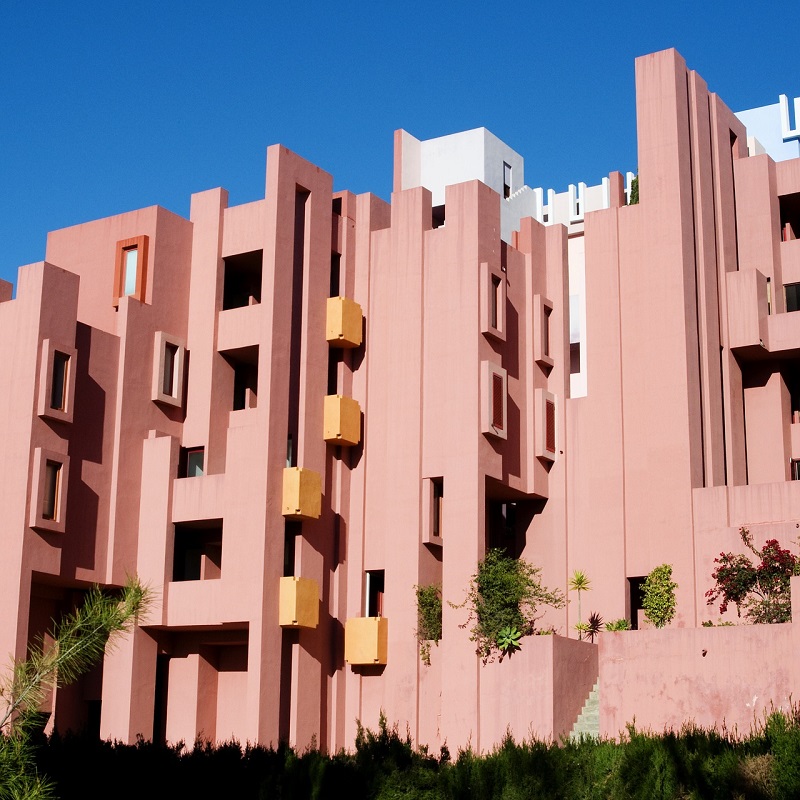Towards a radical eclecticism

|
| Postmodernism at the La Muralla Roja apartment complex in Calpe, Spain by Ricardo Bofill (1968). |
[edit] What is architecture to be about?
‘This is the question facing architects in a consumer society. The basic problems are social, political and metaphysical, not formal and technical. Our society is quite adept at reaching formal and technical standards of excellence, at least in Japan and America, but it has not brought forth either very exciting building tasks or metaphysical mandates. Hence the Surrationalist fantasies (Bofill, OMA, Koolhaas), trying to fill a vacuum; hence the syndicalist utopias or modest attempts at participation (the Kriers, Erskine, Kroll); hence the great American attempt at revivalism and significant cultural form. All these Post-Modern tendencies are trying to give birth to a new architecture before consumer society has given it a mandate; it is the sound, as the saying goes, of one hand clapping. It may be, however, the only sound a consumer society is willing to allow, immersed as it is in the joys of private life. This culture is essentially passive, waiting for the directions from its self-appointed elites. What messages it receives today are extraordinary in their plurality and breadth. To discriminate among these messages, as well as send them, has also fallen to an elite, that is the ‘communications industry’. So we are at a most curious juncture in history that isn’t in fact a turning point at all. Rather we are in for more of the same’, much more, in fact a recapitulation of all historical architecture including that of the recent past. We are, as you will guess, in a Radically Eclectic age, an age that makes the 1870s with its relative paucity of fifteen styles look like an integrated culture. We have more styles and ideologies than they did and they probably mean less; have less conviction and semantic meaning. Gothic Revival is now a-religious and doesn’t carry Pugin’s moralistic fervour; Stirling at one time had Gothic arcades for his Stuttgart Museum before they were changed into Romanesque. In our musée imaginaire, in our museum city that has recapitulated world history, styles have lost their overall meaning and become, instead, genres – classifiers of mood and theme. This is a major point of Radical Eclecticism; it substitutes a time-bound semiotic view of architectural form for the monolithic view of the past, the Modern and Neo Gothic view. Its approach to style and meaning is relativistic, related to the context of the culture being designed for, and this entails changing those styles and meaning perhaps after they have swung too far one way, or, by contrast, need support or confirmation. The two ideas behind this are plenitude and pluralism, the idea that, given the choice, people would rather have a variety of experiences and that, as history proceeds, a plenitude of values, a richness is created on which it is possible to draw. These architectural loans must, to repeat a point, be repaid with interest, that is reinvention. In short, the content of our buildings is not the Space Age or the Energy Problem, not the Machine Age or High Technology, but the variety of cultural experience, the plurality of psychic, social and metaphysical states possible to people. For the museum we have the museum city, for a single meaning of history we have all of history, for a single political view we have the res publica and for architecture we hope for an eclecticism that is radical. A Radical Eclecticism should be founded on requirements of function, hints of the place and the desires of symbolism; it should respond to the tastes of the users while, if it is radical, extending and challenging them with new meaning.’
In: Theories and Manifestoes of Contemporary Architecture, edited by Charles Jencks and Karl Kropf. Academy Editions, 1997.
[edit] About this essay
This essay was written by the architectural historian, critic and writer Charles Jencks (1939-2019) and was republished by Reading Design in 2019 in his memory. Reading Design writes that “it was originally included in the catalogue of the First International Exhibition of Architecture held at the 1980 Venice Biennale, entitled The Presence of the Past. The exhibition, organised by Paolo Portoghesi, was one of the defining events of the Post-Modern movement. In the same way that the International Style exhibition of 1932 at the New York Museum of Modern Art helped crystallise the different strands of Modernism into a recognised style, The Presence of the Past focused the concerns of Post-Modernism for a wider audience.”
The essay was later republished in December 2019 on the website of the Institute for Historic Building Conservation (IHBC) and can be accessed HERE.
Other articles by the IHBC on Designing Buildings Wiki can be accessed HERE.
[edit] Related articles on Designing Buildings Wiki
- Aesthetics and architecture.
- Antiquities.
- Architect.
- Architectural design.
- Architecture.
- Architectural styles.
- Classical orders.
- Classical architecture
- Design methodology.
- Eclecticism.
- English architectural stylistic periods.
- Form follows function.
- Maggies Cancer Centre, Manchester
- Modern building.
- Modernist architecture.
- The architectural profession.
- The history of fabric structures.
- Types of building.
- Vernacular architecture.
Featured articles and news
Government consultations for the summer of 2025
A year of Labour, past and present consultations on the environment, the built environment, training and tax.
CMA competitiveness probe of major housing developers
100 million affordable housing contributions committed with further consultation published.
Homes England supports Greencore Homes
42 new build affordable sustainable homes in Oxfordshire.
Zero carbon social housing: unlocking brownfield potential
Seven ZEDpod strategies for brownfield housing success.
CIOB report; a blueprint for SDGs and the built environment
Pairing the Sustainable Development Goals with projects.
Types, tests, standards and fires relating to external cladding
Brief descriptions with an extensive list of fires for review.
Latest Build UK Building Safety Regime explainer published
Key elements in one short, now updated document.
UKGBC launch the UK Climate Resilience Roadmap
First guidance of its kind on direct climate impacts for the built environment and how it can adapt.
CLC Health, Safety and Wellbeing Strategy 2025
Launched by the Minister for Industry to look at fatalities on site, improving mental health and other issues.
One of the most impressive Victorian architects. Book review.
Common Assessment Standard now with building safety
New CAS update now includes mandatory building safety questions.
RTPI leader to become new CIOB Chief Executive Officer
Dr Victoria Hills MRTPI, FICE to take over after Caroline Gumble’s departure.
Social and affordable housing, a long term plan for delivery
The “Delivering a Decade of Renewal for Social and Affordable Housing” strategy sets out future path.
A change to adoptive architecture
Effects of global weather warming on architectural detailing, material choice and human interaction.
The proposed publicly owned and backed subsidiary of Homes England, to facilitate new homes.
How big is the problem and what can we do to mitigate the effects?
Overheating guidance and tools for building designers
A number of cool guides to help with the heat.
The UK's Modern Industrial Strategy: A 10 year plan
Previous consultation criticism, current key elements and general support with some persisting reservations.
Building Safety Regulator reforms
New roles, new staff and a new fast track service pave the way for a single construction regulator.

























